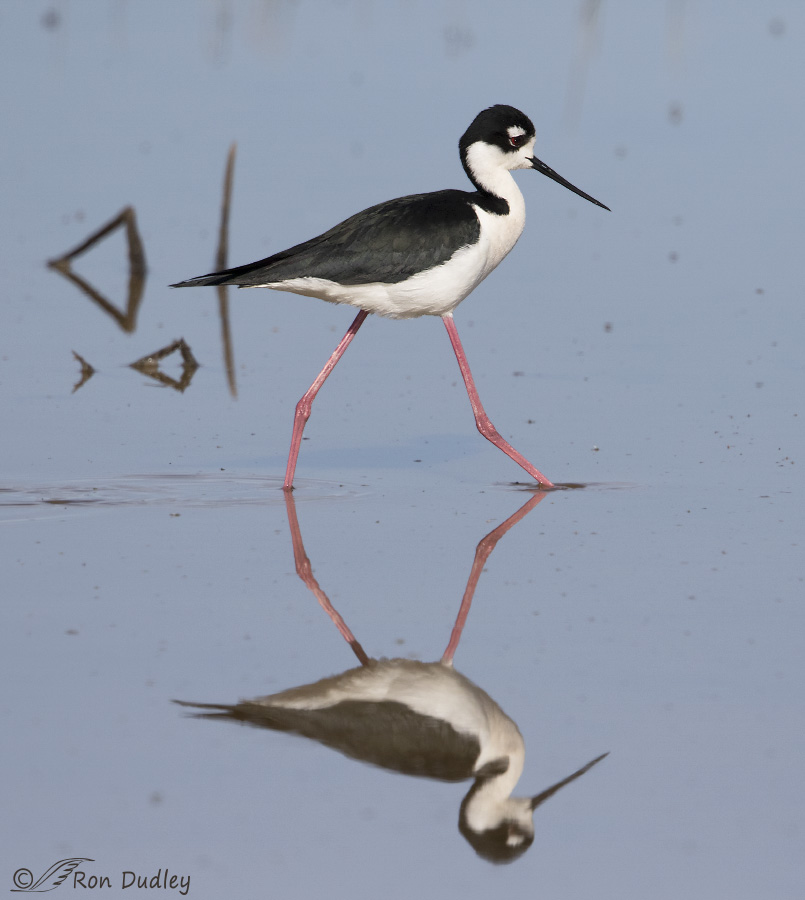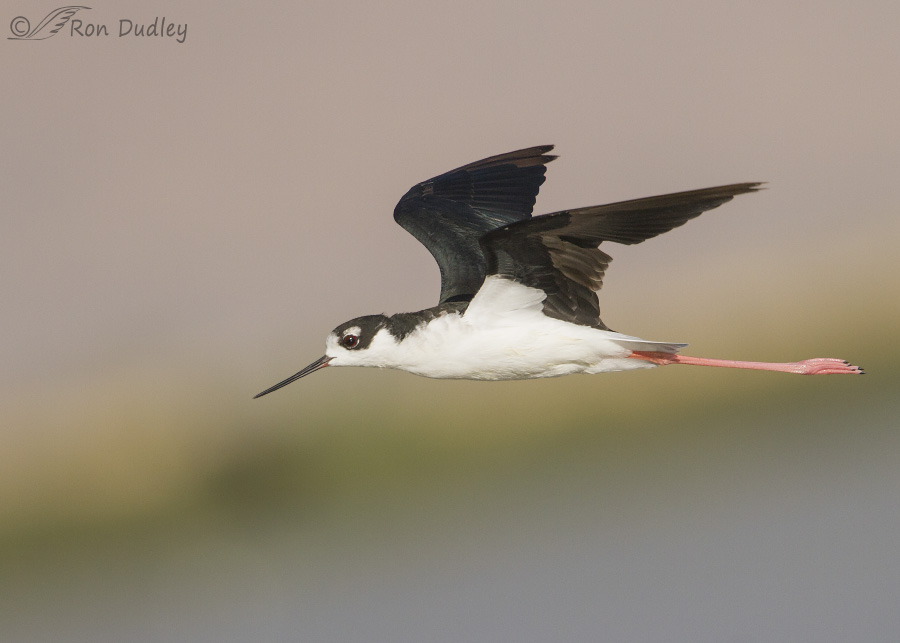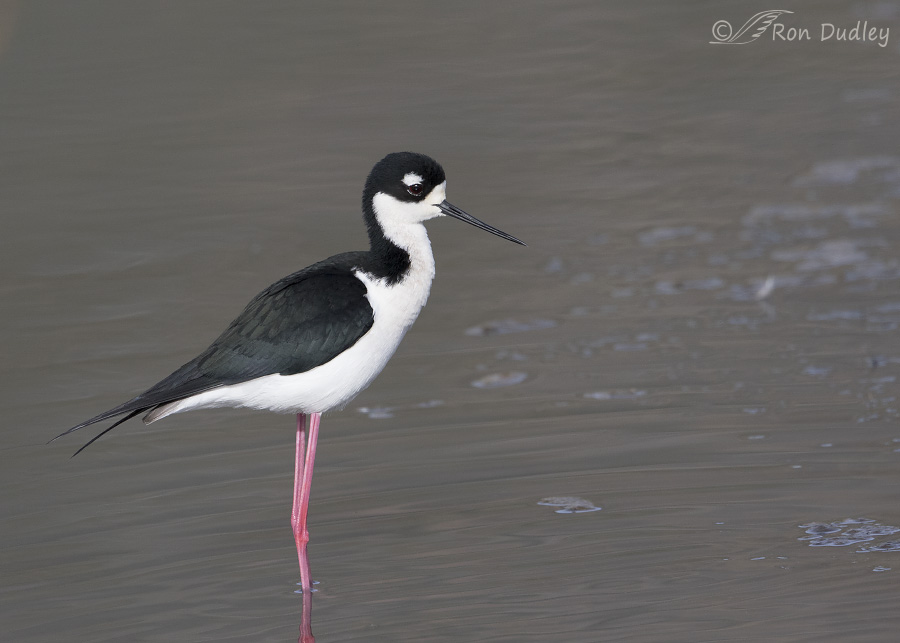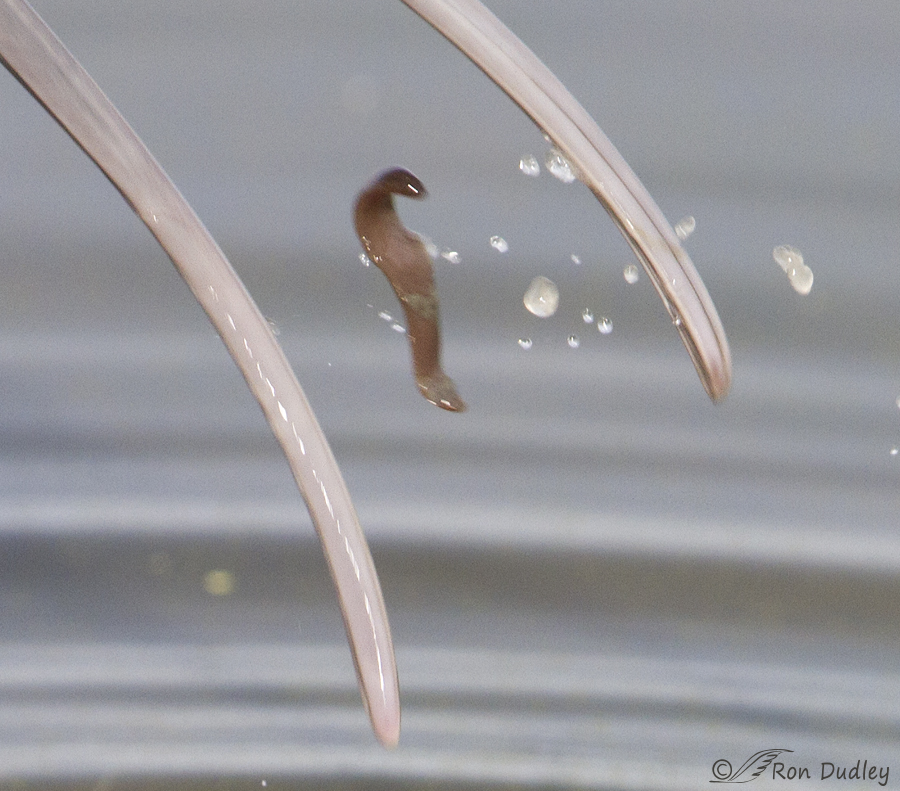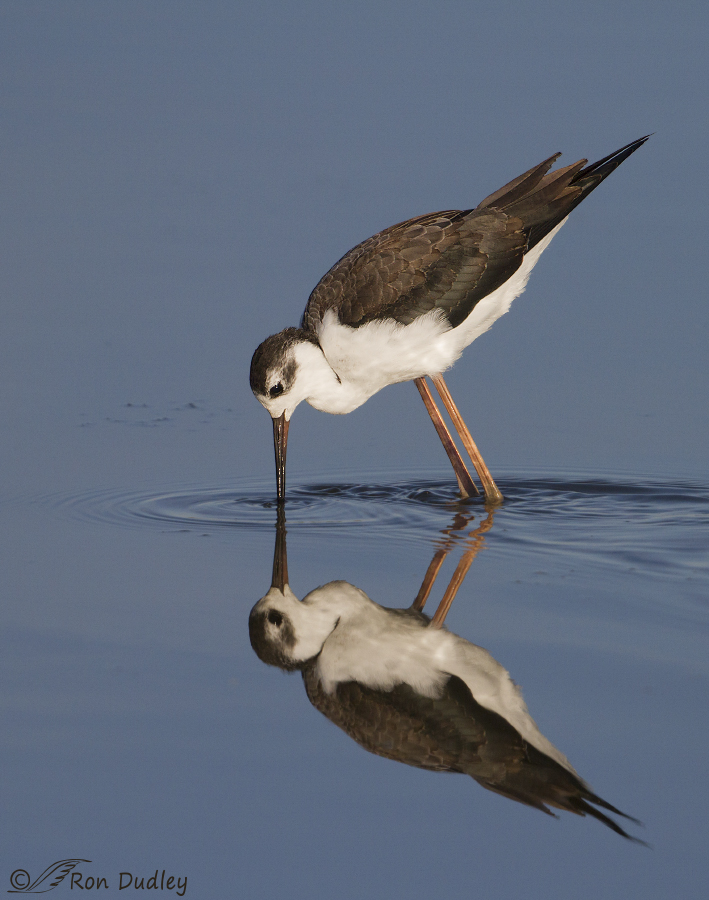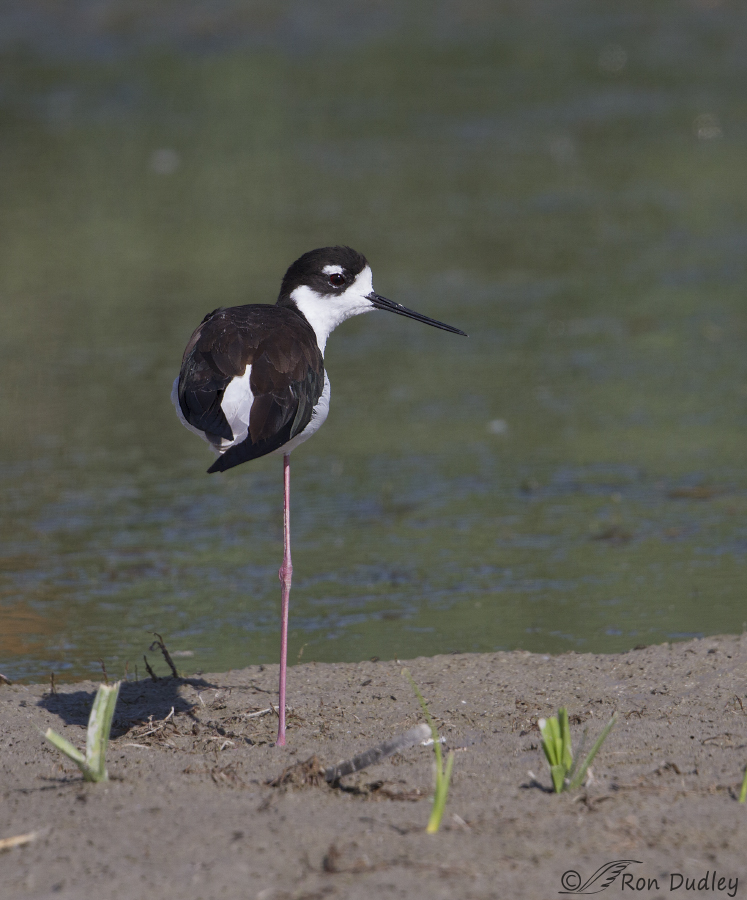Tag: black necked stilt
Black-necked Stilt Flight Series (8 images)
My First Black-necked Stilt Of The Year (and the perils of shooting vertically)
Black-necked Stilt Eating A Fish
The diet of Black-necked Stilts consists primarily of aquatic invertebrates but they’re also known to take the occasional small fish.
Just What Are Those Birds Eating, Anyway?
Black-necked Stilt – An Optical Illusion
This Is Why They’re Called “Stilts”
Mating Black-necked Stilts
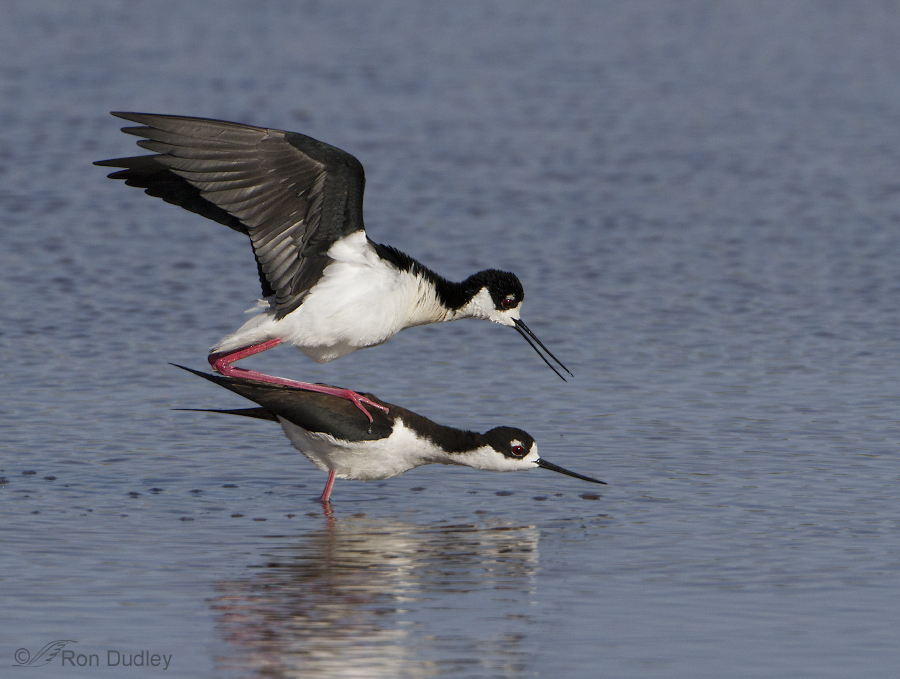
On a recent trip to Bear River Bird Refuge we were photographing American Avocets when I noticed some tell-tale preliminary behavior from a pair of Black-necked Stilts that told me that mating was imminent. So I set up on them and quickly changed my settings for more depth of field and almost immediately the action began.
The Incredibly Long-legged Black-necked Stilt
The Black-necked Stilt is one of the more easily recognized birds in North America. With its shiny black wings and back opposed by the whites of the breast and underparts and its long, bright red legs it is unlikely to be confused with any other species within its range. 1/1000, f/11, ISO 400, 500 f/4, 1.4 tc, natural light But in my experience most observers are unfamiliar with the differences between males and females. Though the sexes are similar it’s relatively easy to tell them apart when they’re in breeding plumage. The back and scapulars of the male are a solid, shiny black while the female has a noticeable brown tone in those areas. The legs of the female are also shorter than those of the male. 1/1250, f/8, ISO 400, 500 f/4, 1.4 tc, natural light The iris of both sexes is red though it is more brightly colored in the male. Here the pupil is dilated to a relatively large size so the colored iris doesn’t take up much of the eye. I’ve found that in photos it can be difficult to get the eye color to show so it often appears solid black. 1/2000, f/6.3, ISO 400, 500 f/4, 1.4 tc, natural light But perhaps the most unique feature of the Black-necked Stilt is those incredibly long, ruby-red legs. Their legs are longer in proportion to their bodies than any other bird except flamingos, accounting for one of their common names – daddy longlegs. Stilts have partially webbed feet…
Black-necked Stilt Stretching and Preening
The Black-necked Stilt is an elegant study in contrasts with its white breast and shiny black wings accentuated by extremely long, bright red legs. They’re often found feeding near American Avocets and I’ve routinely been able to get preening and stretching images of avocets but the stilts have been less cooperative with me. Typically they’ll actively feed when I’m near but they always seem to fly off to do their self-maintenance. 1/2000, f/6.3, ISO 400, 500 f/4, 1.4 tc However, this bird apparently decided that flying off was too much effort and it unexpectedly began a series of stretches. 1/2000, f/6.3, ISO 400, 500 f/4, 1.4 tc I was able to photograph a variety of interesting poses but by this time the sun was relatively high and so some of the best shots are missing light in the eye. Stilts often pull their leg up over the wing when scratching the head. 1/2500, f/6.3, ISO 400, 500 f/4, 1.4 tc Because these birds are usually wading in water when I’m photographing them the extreme length of their legs is not always evident but catch one in a pose like this and it becomes quite apparent. 1/3200, f/6.3, ISO 400, 500 f/4, 1.4 tc I like the water splash and pose in this shot. 1/2500, f/6.3, ISO 400, 500 f/4, 1.4 tc Here the stilt has finished stretching for the moment and is contemplating its next move… 1/2000, f/6.3, ISO 400, 500 f/4, 1.4 tc which turned…
Black-necked Stilt Flight Series (8 images)
My First Black-necked Stilt Of The Year (and the perils of shooting vertically)
Black-necked Stilt Eating A Fish
The diet of Black-necked Stilts consists primarily of aquatic invertebrates but they’re also known to take the occasional small fish.
Just What Are Those Birds Eating, Anyway?
Black-necked Stilt – An Optical Illusion
This Is Why They’re Called “Stilts”
Mating Black-necked Stilts

On a recent trip to Bear River Bird Refuge we were photographing American Avocets when I noticed some tell-tale preliminary behavior from a pair of Black-necked Stilts that told me that mating was imminent. So I set up on them and quickly changed my settings for more depth of field and almost immediately the action began.
The Incredibly Long-legged Black-necked Stilt
The Black-necked Stilt is one of the more easily recognized birds in North America. With its shiny black wings and back opposed by the whites of the breast and underparts and its long, bright red legs it is unlikely to be confused with any other species within its range. 1/1000, f/11, ISO 400, 500 f/4, 1.4 tc, natural light But in my experience most observers are unfamiliar with the differences between males and females. Though the sexes are similar it’s relatively easy to tell them apart when they’re in breeding plumage. The back and scapulars of the male are a solid, shiny black while the female has a noticeable brown tone in those areas. The legs of the female are also shorter than those of the male. 1/1250, f/8, ISO 400, 500 f/4, 1.4 tc, natural light The iris of both sexes is red though it is more brightly colored in the male. Here the pupil is dilated to a relatively large size so the colored iris doesn’t take up much of the eye. I’ve found that in photos it can be difficult to get the eye color to show so it often appears solid black. 1/2000, f/6.3, ISO 400, 500 f/4, 1.4 tc, natural light But perhaps the most unique feature of the Black-necked Stilt is those incredibly long, ruby-red legs. Their legs are longer in proportion to their bodies than any other bird except flamingos, accounting for one of their common names – daddy longlegs. Stilts have partially webbed feet…
Black-necked Stilt Stretching and Preening
The Black-necked Stilt is an elegant study in contrasts with its white breast and shiny black wings accentuated by extremely long, bright red legs. They’re often found feeding near American Avocets and I’ve routinely been able to get preening and stretching images of avocets but the stilts have been less cooperative with me. Typically they’ll actively feed when I’m near but they always seem to fly off to do their self-maintenance. 1/2000, f/6.3, ISO 400, 500 f/4, 1.4 tc However, this bird apparently decided that flying off was too much effort and it unexpectedly began a series of stretches. 1/2000, f/6.3, ISO 400, 500 f/4, 1.4 tc I was able to photograph a variety of interesting poses but by this time the sun was relatively high and so some of the best shots are missing light in the eye. Stilts often pull their leg up over the wing when scratching the head. 1/2500, f/6.3, ISO 400, 500 f/4, 1.4 tc Because these birds are usually wading in water when I’m photographing them the extreme length of their legs is not always evident but catch one in a pose like this and it becomes quite apparent. 1/3200, f/6.3, ISO 400, 500 f/4, 1.4 tc I like the water splash and pose in this shot. 1/2500, f/6.3, ISO 400, 500 f/4, 1.4 tc Here the stilt has finished stretching for the moment and is contemplating its next move… 1/2000, f/6.3, ISO 400, 500 f/4, 1.4 tc which turned…


